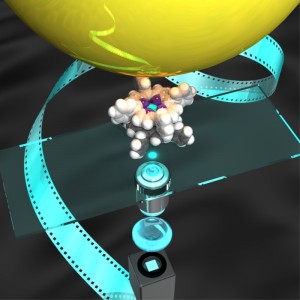Seeing and touching a single 1-nm-sized synthetic molecular machine Motion capture and manipulation of single molecules by optical microscopy

Single-molecule imaging and manipulation with optical microscopy using a bead probe as a marker (single?molecule “motion capturing”) unveils fundamental properties of biomolecular machines such as direction of motion, step size and force the molecule exerts, which cannot be resolved by whole-molecule measurements. As a result, it has become an essential method for research of biomolecular machines. In addition, single-molecule motion capturing could also become a powerful tool to develop “synthetic” molecular machines. However, it is difficult to apply the conventional method to individual molecules because the size of a typical synthetic molecular machine is only 1 nm, about one-tenth the size of a biomolecular machine. This miniaturization of the target molecule causes significant problems such as low efficiency of the bead probe immobilization reaction and undesired interaction between the surfaces of the bead and substrate.

© 2014 Tomohiro Ikeda.
Schematic illustration for single-molecule motion capturing and manipulation of 1-nm sized synthetic molecular machine by optical microscopy using a bead probe. A large bead attached to the rotor part of the synthetic molecular bearing (double decker porphyrin) traces its motion.
Professor Hiroyuki Noji, Dr. Tomohiro Ikeda and Mr. Takahiro Tsukahara at the Department of Applied Chemistry, Graduate School of Engineering, the University of Tokyo, Professor Ryota Iino at the Okazaki Institute for Integrative Bioscience/Institute for Molecular Science, National Institutes of Natural Sciences (formerly Associate Professor at the University of Tokyo), and Professor Masayuki Takeuchi at Organic Materials Group, Polymer Materials Unit, National Institute for Materials Science, captured the motion of a single synthetic machine about 1 nm in size for the first time. In this experiment, the researchers resolved the problems in the conventional method which are caused by the small size of the target and successfully visualized the rotational motion of a single double-decker porphyrin (DD), known as a synthetic molecular bearing, by imaging a bead on DD. Furthermore the researchers successfully manipulated the motion of the single DD molecule by applying an external force to the bead.
This method, that allows us to “see and touch” single synthetic molecular machines, provides currently the only strategy to verify and evaluate the performance of synthetic molecular motors generating force, one of the ultimate goals in the development of synthetic molecular machines. For example, if it were possible to create a light-driven synthetic molecular motor connected to a biomolecular motor, it should then be possible to establish a tailor-made energy conversion system that can control various chemical reactions by application of light. Therefore this seminal technique will contribute to establishment of tailor-made energy conversion systems based on molecular machines.
This research is featured on the back cover of the journal Angewandte Chemie International Edition.
This work was supported by CREST (Core Research for Evolutional Science and Technology) of the Japan Science and Technology Agency.
Paper
Tomohiro Ikeda, Takahiro Tsukahara, Ryota Iino, Masayuki Takeuchi, and Hiroyuki Noji,
“Motion Capture and Manipulation of Single Synthetic Molecular Rotors by Optical Microscopy”,
Angewandte Chemie International Edition Online Edition: 2014/7/2, doi: 10.1002/anie.201403091.
Article link
Links
Graduate School of Engineering
Department of Applied Chemistry, Graduate School of Engineering
Noji Laboratory, Department of Applied Chemistry, Graduate School of Engineering (Japanese)







